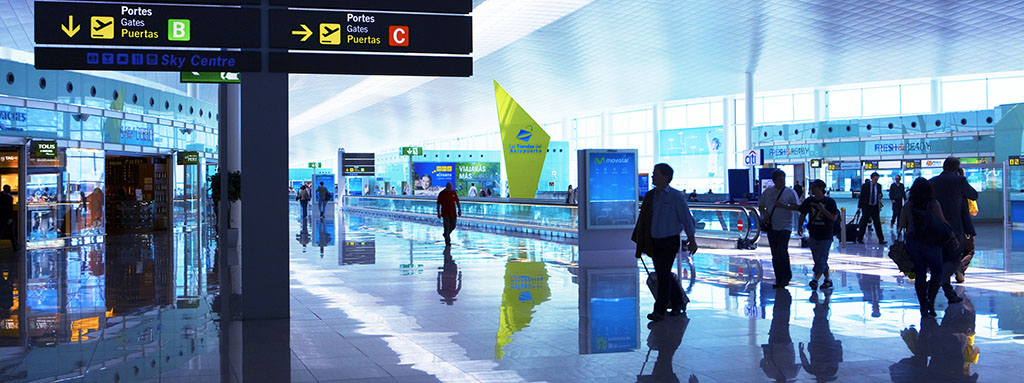
We have long been hearing from entities involved in airport development across the globe about the benefits the future is going to bring to airports and airport environments. What’s more, hardly a day goes by in which we don’t hear about some new technological breakthrough that has been implemented or is going to be developed in an airport somewhere in the world.
A goal pursued by any airport is for passengers to be able to transit the building and reach their boarding gate without having to be constrained by endless queues to get through airport security.
The truth is that we are currently experiencing a high-speed race in the transformation of our airports, principally due to two factors.
Firstly, technology is advancing very quickly. The speed of technological innovation is measured on an exponential scale that rarely allows anyone to predict what the next step forward is going to be or how soon it is going to occur. The latest breakthrough is the sudden mass emergence of artificial intelligence in a wide variety of processes. Along with Big Data, this is achieving rates of task automation, optimisation and efficiency that would have been impossible to predict even just a few years ago.
The convergence of various different kinds of technology in each of the processes that occur in airports is playing a key role in the improvement of their management and operation.
The second factor involved is the cascade of investments that have been continually occurring in airports all around the world – not only for the construction of new airport mega installations, but also for the renovation and expansion of existing airports. These works incorporate a huge technological component that is totally transforming the facilities and services provided. There is not a single region in the world where this is not happening.
This change has significant impacts not only on passenger experience, but also on every other activity carried out in airports and airport environments. In reality, the future – if we can call it that – is much more present in the things that we can’t see, rather than in the things we experience directly as passengers.
There is a barrier that appears repeatedly in any airport wishing to invest in technology and innovation with the aim of improving its management on all fronts. And that barrier is security.
Airports are infrastructures designed to handle the passage of thousands of people through their facilities every day, while also providing work for thousands of professionals. Consequently, security is a critical factor.
We have to assume that the day will come where the intelligence installed in an airport will be aware of everything (or almost everything) regarding any person who is passing through the airport in real time, whether they be an employee or a passenger. Not only that, but it will also be able to systematically analyse the behaviour displayed by any person at any given time, and autonomously decide whether a person constitutes a threat or not.
A goal pursued by any airport is for passengers to be able to transit the building and reach their boarding gate without having to be constrained by endless queues to get through airport security. We all know that 99% of people who travel through an airport do not pose any kind of threat. However, currently we must all pay the price in terms of stress, time and comfort that comes from the fact that the remaining 1% do pose a threat, and cannot be easily and accurately identified.
The use of Big Data and artificial intelligence is key to resolving this type of problem. For example, facial recognition already enables the automation of security checks in certain controlled environments. Other more basic biometric techniques have already become an unequivocal identification method across many airports in the world. The automation of techniques in the analysis of behaviour patterns is another concept that is already being tested in some facilities. And this is only the beginning.
Another interesting aspect is how technological innovations can contribute to passengers consuming increasingly more in airport terminals, due to customised real-time information regarding the options available based on the passenger’s tastes and preferences.
At first glance this may seem to go against what we have previously said about facilitating a passenger’s speedy access to the aeroplane. However, a closer look reveals this not to be the case. The trend set by technological advances in airports is heading toward customisation. A passenger should be able to choose whether they want to go directly to their boarding gate, or whether they would rather make the most of some leisure time in the terminal. At the same time, it is logical and desirable that an airport may want to know whether this person, or their behaviour at any given time, constitutes a threat.
It is an undeniable fact that technology is changing airports in every respect, and at a very fast rate. It’s possible that we usually don’t see beyond the exterior, which is often spectacular. However, the truth is that every step we take inside a terminal or on board an aircraft will be monitored by technology that is undoubtedly on our side.
Have a good flight.
Some recommended reading:
Bloomberg: “The airports of the future are here”
BBC News: “Facial recognition to be used at Singapore airport”
Future travel experience: “10 technology trends for airlines and airports in 2018”
CAPA: “Airport technology / What passengers want: greater personal control of the airport process”
Future airports: “web”

